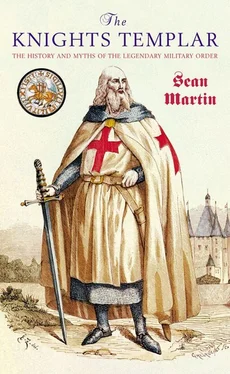Sean Martin - The Knights Templar
Здесь есть возможность читать онлайн «Sean Martin - The Knights Templar» весь текст электронной книги совершенно бесплатно (целиком полную версию без сокращений). В некоторых случаях можно слушать аудио, скачать через торрент в формате fb2 и присутствует краткое содержание. Год выпуска: 2004, ISBN: 2004, Жанр: История, на английском языке. Описание произведения, (предисловие) а так же отзывы посетителей доступны на портале библиотеки ЛибКат.
- Название:The Knights Templar
- Автор:
- Жанр:
- Год:2004
- ISBN:1-904048-28-5
- Рейтинг книги:3 / 5. Голосов: 1
-
Избранное:Добавить в избранное
- Отзывы:
-
Ваша оценка:
- 60
- 1
- 2
- 3
- 4
- 5
The Knights Templar: краткое содержание, описание и аннотация
Предлагаем к чтению аннотацию, описание, краткое содержание или предисловие (зависит от того, что написал сам автор книги «The Knights Templar»). Если вы не нашли необходимую информацию о книге — напишите в комментариях, мы постараемся отыскать её.
The Knights Templar — читать онлайн бесплатно полную книгу (весь текст) целиком
Ниже представлен текст книги, разбитый по страницам. Система сохранения места последней прочитанной страницы, позволяет с удобством читать онлайн бесплатно книгу «The Knights Templar», без необходимости каждый раз заново искать на чём Вы остановились. Поставьте закладку, и сможете в любой момент перейти на страницу, на которой закончили чтение.
Интервал:
Закладка:
The New Knighthood
After the victory of the First Crusade, most of the surviving crusaders returned to Europe, leaving Baldwin de Boulogne – Godfroi having died unexpectedly in the autumn of 1100 – to assume the title of the first King of Jerusalem. His domain stretched south to the Red Sea, and north as far as Beirut. Above that lay the County of Tripoli, ruled by Raymond de Saint-Gilles, Count of Toulouse. North of Tripoli was the Principality of Antioch, whose ruler was Bohemond of Taranto. The two remaining Christian kingdoms were the County of Edessa to the north-east – the first Latin kingdom to be established by the crusaders, in 1098 – and Cilician Armenia to the north-west, in what is now Turkey. Outremer, being as it was a collection of small, largely coastal kingdoms ruled by allied European nobles, was largely modelled on the feudal system that had dominated Europe since the late Dark Ages.
After the fall of the Roman Empire in the West, Europe was ravaged by successive waves of invaders: the Saracens and Magyars from the east; the Vikings from the north. In addition, kingdoms were constantly engaged in squabbles with one another, and this uncertain political climate gave rise to what became known – from the sixteenth century onwards – as the feudal system. None of the kingdoms of Europe had a centralised power base and, as a result, monarchs were largely powerless to protect their people. In order to secure some form of protection and to feed his family, a man would have to offer his services to the local landowner. With no such thing as a standing army, the landowner would always need to call upon men to fight to protect his dominions. Thus, the man swore loyalty to the lord, and became known as his vassal. Vassalage required that the man swear an oath of loyalty to his lord and be on call to fight for him whenever the need arose. In return, the lord would provide the vassal with land (or sometimes the income from ecclesiastical institutions), which would feed the vassal’s family and also bring in revenue to the lord’s exchequer from taxes levied on the vassal’s land.
It was against this background that knights began to emerge. The lord–vassal system may have had its origins in the old Roman practice of commendation, in which a soldier would pledge service to an officer of superior rank in return for a reward to be decided by the officer. Usually it took the form of a grant of land, which was known as a benefice. European monarchs, such as Charlemagne, began to adopt this practice, and gave their best warriors grants of land. The warriors in turn would take on vassals to work the land on their behalf, thus leaving them essentially free to develop their military and equestrian skills. However, although both knight and vassal were made to swear oaths of loyalty to their lord, it was possible for them to move on to serve another lord if the protection provided proved to be inadequate, or if the lord in question was deposed or killed. In most cases, though, the relationship between lord, knight and vassal became hereditary.
The crusaders who stormed Jerusalem in the summer of 1099 were a mixture of lords, knights and vassals, and all had been promised full remission of their earthly sins for taking part in the Crusade, or pilgrimage, as it was called. The lure of remission also proved an enticing prospect for other, less savoury characters. This latter group included convicted criminals and excommunicates, who used the Crusade as a means of escaping punishment back home. Thus, when the city was safely in Frankish hands, most of the surviving crusaders returned to Europe, having achieved their objectives in taking the Holy City and also having absolved themselves of all wrongdoing. Baldwin then faced the problem of ruling a kingdom with no standing army to protect it.
Despite the fact that all the major cities and ports of Outremer were in Christian hands, the kingdom’s roads were anything but secure. Even when under Muslim control, the Holy Land had continued to attract Christian pilgrims, and now that a Christian king sat on the throne of Jerusalem, they came in even greater numbers. The sites they visited were known simply as The Holy Places, and were scattered throughout the Kingdom: Sephoria was where the Virgin had spent her childhood; in Bethlehem, there was the site of the Nativity; the River Jordan was the scene of Christ’s baptism by John the Baptist (whose cave dwelling was nearby); while various locales around the Sea of Galilee were witnesses to Christ’s ministry. Mount Tabor was the site of the Transfiguration, while the road from Jerusalem to Jericho was the location of the Good Samaritan’s charity.
However, the pilgrims were never safe once they were outside the walls of Jerusalem, as attacks by bands of Saracen robbers were frequent. Even as early as 1106, there were reports of trouble. A Russian abbot by the name of Daniel wrote of his visit to the tomb of St George at Lydda that year:
‘And there are many springs here; travellers rest by the water but with great fear, for it is a deserted place and nearby is the town of Ascalon from which Saracens sally forth and kill travellers on these roads. There is a great fear too, going up from that place into the hills.’ 3 3 Daniel, ‘The Life and Journey of Daniel’, in Jerusalem Pilgrimage , ed. J.Wilkinson, Hakluyt Society 167 (London, 1988). Quoted in Barber, The New Knighthood (Cambridge University Press, 1994), p.3.
But that was nothing compared to Galilee:
‘This place is very dreadful and dangerous … many tall palm trees stand about the town like a dense forest. This place is terrible and difficult of access for here live fierce pagan Saracens who attack travellers at the fords.’ 4 4 Daniel, ibid. Quoted in Barber, op. cit. , p.6.
Thirteen years later, things had got even worse. At Easter 1119, a group of 700 pilgrims was attacked by Saracens on the road to the River Jordan; 300 were killed and 60 carried off into slavery. Later that year, the forces of Roger, Bohemond II of Antioch’s regent, were ambushed and killed at the Field of Blood. This led to a flurry of requests for further aid from the West, and a council of Church leaders met in Nablus in January 1120 to address the issue.
At the time that Roger and his men met their fate on the Field of Blood, Baldwin’s successor, Baldwin II, had been on the throne of Jerusalem for a year. It is thought that at some point during 1119 he granted an audience to two French noblemen, Hugues de Payen from Champagne and Godfrey de St Omer from Picardy. Together with seven other knights, they proposed to guard the pilgrims as they made their way to and from the Holy Places. But they would not do so as regular knights – they would live as a small monastic community, following the rule of St Augustine. Baldwin liked the idea. Manpower had always been an issue in Outremer and the fact that Hugues and his brethren were prepared to live as monks meant that they would be, in theory, more dependable than some of the rabble who had taken part in the First Crusade. The king approved the plan and, on Christmas Day, Hugues and Godfrey swore vows of poverty, chastity and obedience before Baldwin and Warmund of Picquigny, the Patriarch of Jerusalem, in the Church of the Holy Sepulchre, and Baldwin gave them quarters at the al-Aqsa mosque on the Temple platform. The Order of Poor Knights of the Temple of Solomon, the Order of the Temple, The Knights Templar, was born.
Within weeks of the founding of their order, the Templars were introduced to the clergy at the Council of Nablus. The nine knights were accepted by those present, and Hugues and his brothers began their task of policing the kingdom. The other founding knights were: Payen de Montdidier; André de Montbard; Archambaud de St Aignan, Geoffrey Bisol; two knights known only by their Christian names of Roland and Gondemar; while the ninth member remains unknown.
Читать дальшеИнтервал:
Закладка:
Похожие книги на «The Knights Templar»
Представляем Вашему вниманию похожие книги на «The Knights Templar» списком для выбора. Мы отобрали схожую по названию и смыслу литературу в надежде предоставить читателям больше вариантов отыскать новые, интересные, ещё непрочитанные произведения.
Обсуждение, отзывы о книге «The Knights Templar» и просто собственные мнения читателей. Оставьте ваши комментарии, напишите, что Вы думаете о произведении, его смысле или главных героях. Укажите что конкретно понравилось, а что нет, и почему Вы так считаете.












